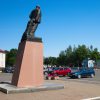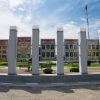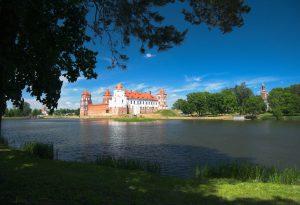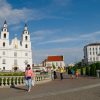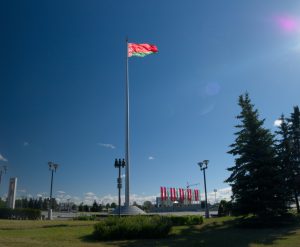Pripjať river surroundings
First impressions from Belarus:
- Better roads than in Ukraine, more polite border guards, more tidy towns and villages, waste bins in public places
- Better infrastructure was maybe paid indirectly by everyone, by their savings vanished via inflation. First they cancelled one zero on banknotes during transfer from Soviet to Belarussian ruble, then next 3 zeroes in 2000 and next four in 2016. So now one ruble is 1/3 Euro, but the coin is small, possibly in expectation of further inflation
- Even fewer villages and further apart
- The typical Ukrainian white-blue village houses replaced by local typical wooden-blue
- There were storks already in Ukraine, but here is it slowly reaching the standard in Poland, where every village needs to have at least one stork nest on top of electricity poles
- You cannot get lost in the towns: the main street is called Lenin’s and you can recognise it by a statute of Lenin. Other streets follow the pattern: Communistic, Soviet, Comsomol, Karl Marx, Dzerzhinsky, etc. At the same time there needs to be a new church on the main streat.
I was pleased by the price of river transport here. I arrived into Belarus in the Pripyat river area and I needed to get over the river – by a ferry. But only when I got to the river bank I realised I do not have a single Belarussian ruble. The nearest ATM on the other side of the river, the shortest alternative route there 150 km around – and I did not have enough food and drink for such detour. Luckily it turned out the ferry is simply for free here. On top of it, I later found out you don’t need rubles even to get the food – even village shops typically accept cards.
Amids Belarus
The area was in the past fought over by catholic Polish nobility, orthodox russian Cossacs and tsars and muslim Mongols and then Turks. Poles fortified themselves in castles. After all later wars the ones in Nesvizh and Mir are still preserved.
Same as in Ukraine, also in Belarus I reached the highest summit of the country, cycling to the very top of the Mount Dzerzhinsky. Then I washed off the mountaineering sweat and headed for Minsk.
Minsk
Same as in Kiev or Chisinau, Minsk is blocked from all sides by multi-lane motorways. However, here the motorways have wide enough and rideable shoulders and at the city boundary appear cycling lanes next to pavements, leading across the entire city. So to arrive on a bike was surprisingly easy. The difference is also immediately visible in the numbers of local cyclists.
Like the rest of Belarus, also Minsk makes a very tidy impression. The preserved historical centre is not huge, but it is pleasant to walk through by a network of low-traffic side streets and passages. From the centre out radiate huge boulevards with high-rises. There are again well preserved Soviet memorials, next to churches and McDonalds’. The city also has a surprisingly large number of museums – from those easy to expect, like Museum of the Great Patriotic War, to the more original ones, like Cat Museum, or Museum of the First Congress of Russian Social Democratic Party.
Naroch
North of Minsk is a natural park of many lakes centered at the Naroch lake, with beautifully clean water and plenty of herons.










